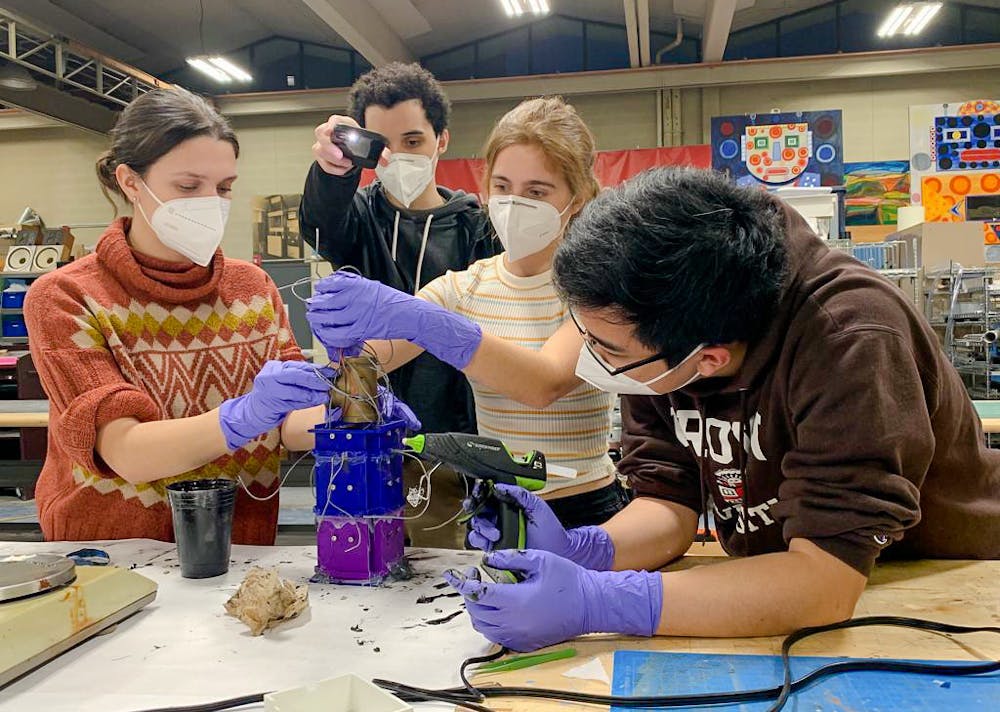SBUDNIC, a student-led team building a nanosatellite, is at “crunch time” in its preparations despite delaying its original launch, which had been scheduled for tomorrow in Florida, according to program manager Dheraj Ganjikunta ’22.
The SpaceX Falcon 9 rocket which was supposed to carry the satellite to orbit no longer had available space on board. The new launch will take place in June at the Vandenberg Air Force Base in California, according to Ganjikunta.
The nanosatellite, a 3U Cubesat, is being built with only “terrestrial” parts — materials not designed for space — including cheaper, off-the-shelf components such as AA batteries, The Herald previously reported.
The project came out of ENGN 1760: “Design of Space Systems,” taught by Rick Fleeter ’76 PhD’81, adjunct associate professor of engineering. Fleeter was offered space on board a SpaceX Falcon 9 rocket for a small satellite and presented the opportunity to his students, who “grabbed onto” the idea, he said. Once in space, the satellite will orbit at an elevation of approximately 500 kilometers, The Herald previously reported.
“There’s a sense in the satellite world that things have … to be leading edge (and) every mission has to be greater than the one before it,” said Fleeter, who is also the team’s advisor. “I think we’ve lost the grassroots — what we can do that is super simple, but still meaningful.”
In the space industry, companies are able to produce satellites in a few months, since they already have predetermined designs and benefit from an existing production line, according to Ganjikunta.
“What’s really impressive is that we've fully designed, tested and launched in about a year,” Ganjikunta said, pointing to the team’s design made entirely from terrestrial parts. When things go wrong in building and testing the satellite, new parts are easy to find, he added.
“That's a big part of the program overall,” Ganjikuta said. “You shouldn't have to wait months on these space-qualified parts.” If the team had used space batteries and other space-qualified parts, the satellite would have taken much longer to build due to supply chain issues, he explained.
The SBUDNIC team is currently preparing its satellite for pre-qualification testing in mid-March, which will consist of a series of vacuum, thermal and vibration tests. If the satellite passes these tests, it will qualify for launch in June.
Until then, the group is conducting its own testing on campus and solving problems that arise along the way. One of these tests includes using a paint shaker to mimic vibrations the satellite might encounter on the launch. The group also plans to use dry ice to mimic extreme thermal conditions, said Julien Cormary ’24, SBUDNIC subsystem managing engineer, who works on thermal aspects of the satellite.
The integration of the satellite with all of its parts is one of the aspects of the process most prone to problems, as each individual piece of the satellite was built independently of the others, according to Ganjikuta.
Fleeter said he’s encouraged the team to be creative and “think about a crazy way” to solve any problems that may arise. “It's been a lot of ingenuity on their side,” he added.
When two team members forgot to order a USB A to USB C converter, they tried joining two phone chargers together as a replacement, according to SBUDNIC program director Selia Jindal ’24. At another point, team members used a heat gun when they needed to melt the plastic off of a USB key, Cormary said.
“This is a very different way to work and approach problems that I have found incredibly helpful,” Cormary said. “Learning how to tackle problems from a ‘just do it, see what happens’ perspective has been a different experience to those in classes, which may focus more on equations or theory.”
If the satellite is qualified after testing, the team hopes to travel to the Vandenberg Air Force Base to see out the launch as well as to make last-minute repairs, Ganjikunta said.
The team will be surrounded by “some of the biggest and most expensive satellites in the world” at the launch base, Fleeter said. “It’s going to be intimidating.”
Once the satellite is in space, the team will have to try “talking to” the satellite, Fleeter said, though the satellite will only be in an ideal position for communication for about 10 minutes a day.
“It's just the nature of space that something might not work, but that's not what we're focused on,” Cormary said. “We're going to give it every chance to work, and that excitement that it just might work is what's fueling us all right now.”
Jindal said she is excited to “pull some more late hours” putting the satellite together.
“I think we've all learned a lot and what we've done is incredible, regardless of what happens in June,” Jindal said. “I'm excited to see the project through and to see what comes next for our team and our program.”
Haley Sandlow is a contributing editor covering science and research. She is a junior from Chicago, Illinois studying English and French.





